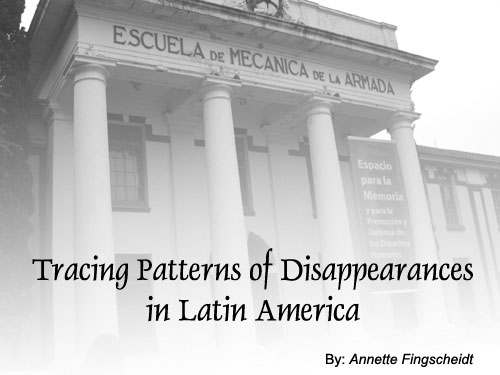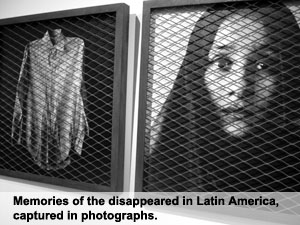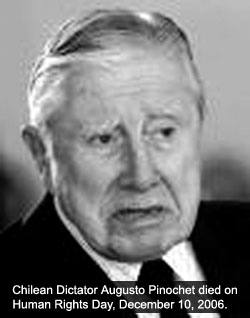|
TABLE OF CONTENTS
EDITORIAL
COVER STORY
- Realizing A World Without Desaparecidos
COUNTRY SITUATIONS
- The Making of Nepal’s Anti-disappearance Law
- Disappearances & Fake Encounters
NEWS FEATURES
- Claimants 1081
- Tracing Patterns of Disappearances in Latin America
- For the Want of Peace & Justice
- Probing Deeper into Munir’s Death
- Out of the Shadows
- Reclaiming Stolen Lives
PHOTO ESSAY
INTERNATIONAL SOLIDARITY
- Growing Federation
- At the Heart of Buenos Aires
REPRINT
- Submissions to the Independent Group of Eminent Persons
STATEMENTS
- Exhuming Truth
- Joint Statement of Independent Observers for the GRP - NDF Peace Process
POEM
- Of The Vanished
|
News Feature

For decades, Latin America was the part of the world which most people would associate with the disappearance of persons, the majority of whom were political dissidents or suspected to be “subversives.” During the military dictatorships between the 1970s and 1980s in the Southern Cone (Chile, Argentina, Paraguay and Uruguay), leftist opponents and popular leaders were identified as “enemies of the fatherland” and were systematically eliminated. Tens of thousands of persons were illegally detained and tortured in secret detention centers; many of them disappeared without a trace.
Military rule in Latin America was, in each and every case, backed or even installed by the United States, under the pretext of the national security doctrine which aimed to curb any effort to build up a leftist regime similar to Cuba. Latin American military officers were (and are still) trained in the so-called School of the Americas, where not only military tactics were taught but also the theory and practice of torture.
The bereaved families desperately looked for their loved ones in police stations, military garrisons, hospitals and morgues. In addition to having been witnesses to the detention carried out by uniformed men in many cases, families had to bear the traumatic experience of being denied the truth regarding the fate and whereabouts of their missing loved one. Some were even told that their family member simply did not exist. They were, however, aware that the missing person had been arrested by the authorities and that somebody had to know about his or her fate. From this arose the figure of the
desaparecido. And as this practice spread across the world, the desaparecido came about to explain the unexplainable. The presumed perfect crime – killing without a corpse for evidence – was given a name.
The families of the disappeared, mainly mothers, wives and daughters, raised their struggle and curiously, through their public protests and their tireless demand for Truth and Justice, the most invisible victims of military rule became the motor for the fight against impunity in the coming decades.
Soon the massive and systematic practice of enforced disappearance became widely known and condemned internationally. The pattern of disappearances was clear. Disappearance was a crime committed exclusively by state actors; the targets were unarmed civilians, mainly working class political activists and leftist urban intellectuals.
During military rule in the Southern Cone countries, every case of disappearance was recorded by the authorities responsible for the crime. In some cases, they even took the fingerprints of those tortured to death or those executed extra-judicially before secretly dumping or burying the bodies. These records later proved valuable when human rights organizations and truth commissions started documenting cases of disappearances.
Disappearances in the context of armed insurgency
With the outbreak or intensification of civil wars in Central America (especially in Guatemala and El Salvador) and in the Andean region (Peru and Colombia) in the 1980s, the pattern of disappearances changed. This crime as well as other grave human rights violations were now committed under the context of internal armed conflict. The army, equipped and trained by the U.S., applied the “strategy of devastated earth,” a tactical method used to erase any popular support to the guerilla forces. Consequently, the rural areas were greatly depopulated. More, it drove thousands of peasant families in the small Central American countries to flee to neighboring Honduras or Mexico. In the Andean region, they became displaced persons within the boundaries of their home countries. Those who did not manage to escape the army operations were brutally killed. Thousands disappeared. The survivors later gave testimonies of the unimaginable cruelties they experienced.
Most of the victims of these disappearances were poor peasants belonging to the traditionally most underprivileged and oppressed groups of society. Even though some of them had been direct guerilla supporters and many sympathized with the armed liberation struggle, they were clearly unarmed civilians. The massive human rights violations committed in Guatemala constituted a clear case of genocide because majority of the victims belonged to the indigenous Maya population.
 Considering the high number, unknown status and poor economic conditions of the victims, the documentation of such cases committed in the context of armed conflict has been extremely difficult. The identity of these victims was even unknown to the perpetrators since they were not targeted individually. Moreover, the military tried to cover up the crimes by blocking human rights activists from accessing the places where massacres occurred. Families fled and lived in different countries, thus, their knowledge about the fate of their beloved was often very limited. These are also the reasons why none of the truth commissions in El Salvador, Guatemala and Peru aspired to elaborate a complete list of victims unlike in Chile and Argentina. Particularly in Central America, the reconstruction of the entire truth and hence, the collective memory, is still a pending task. In Colombia, due to the ongoing conflict, no complete official record of the human rights violations committed exists so far. Considering the high number, unknown status and poor economic conditions of the victims, the documentation of such cases committed in the context of armed conflict has been extremely difficult. The identity of these victims was even unknown to the perpetrators since they were not targeted individually. Moreover, the military tried to cover up the crimes by blocking human rights activists from accessing the places where massacres occurred. Families fled and lived in different countries, thus, their knowledge about the fate of their beloved was often very limited. These are also the reasons why none of the truth commissions in El Salvador, Guatemala and Peru aspired to elaborate a complete list of victims unlike in Chile and Argentina. Particularly in Central America, the reconstruction of the entire truth and hence, the collective memory, is still a pending task. In Colombia, due to the ongoing conflict, no complete official record of the human rights violations committed exists so far.
In relation to the issues of justice and reparation, disappearances and other gross human rights violations committed in the context of armed conflict have raised problems which the Southern Cone countries have not faced. And in addition to the risk of total anonymity of both victim and perpetrator, the clear boundary between these two actors has often been blurred when civilians are obliged to collaborate with one of the armed actors or even participate directly in hostilities. (In Colombia’s ongoing civil war, this practice persists.) Some examples will illustrate the problem:
Within the framework of its counter-insurgency strategy, the Guatemalan army engaged local peasants to serve as so-called “Self-Defense Patrols,” thereby often taking advantage of existing local conflicts over land. Consequently, peasants killed and “disappeared” fellow neighbors. Sometimes they did it voluntarily; sometimes they were forced to do it to protect their own lives.
In 2003, these former Self-Defense Patrols demanded reparation from the state since, according to them, they were forced to commit all those atrocities against their own people. However, this demand was forwarded to the Government before having settled the issue of reparation to victims or even before undertaking any serious effort to bring those responsible for massive human rights violations to justice. This, then, exacerbated the existing feelings of hatred and fear within rural communities.
In the southern and central Peruvian highland, the epicenter of armed struggle during the 1980s, indigenous community leaders decided on their own to take up arms to defend themselves from army incursions and attacks from the Maoist guerilla movement called “Shining Path.” Sometimes they violently eliminated community fellows they suspected as spies and collaborators. On the other hand, Shining Path members, when captured by the military or the police, ran a high risk of being disappeared. The Peruvian Truth and Reconciliation Commission documented numerous cases of these human rights violations. Many armed actors who committed atrocities against defenseless civilians later became victims of human rights violations. This has caused a heated debate on the conditions of state reparation to victims among government officials and parliamentarians, as well as the families of the victims and human rights organizations. Many families do not want to be leveled with terrorists. Furthermore, the international human rights standards state that reparation should be granted to anybody, independent of his or her antecedents.
 Also in Colombia, many victims of enforced disappearances were militants of different guerilla movements. Therefore, families did not often dare to denounce the disappearance of their loved ones. In 2000, after years of struggle, the families’ association achieved an important goal when enforced or involuntary disappearance was included as a crime in the national penal code. More, they managed to establish a clear distinction between disappearances committed by state or para-state actors, and the kidnappings carried out by the guerilla forces aimed to extort or to exert political pressure on the government. Also in Colombia, many victims of enforced disappearances were militants of different guerilla movements. Therefore, families did not often dare to denounce the disappearance of their loved ones. In 2000, after years of struggle, the families’ association achieved an important goal when enforced or involuntary disappearance was included as a crime in the national penal code. More, they managed to establish a clear distinction between disappearances committed by state or para-state actors, and the kidnappings carried out by the guerilla forces aimed to extort or to exert political pressure on the government.
Disappearances today: an exclusive domain of the state?
In war-torn Colombia, successive endeavors to bring about serious peace talks between the government and the guerilla forces have failed so far. The current government, in order to attract international foreign aid as well as political support from the European Union, engaged instead in “negotiations” with their paramilitary allies who have committed the most aberrant acts of cruelty against the rural population, including enforced disappearances, with the direct support or at least the connivance of the military. These pseudo-negotiations led to an equally pseudo-demobilization of paramilitary fighters during the past two years even though some of their prominent leaders had to be prosecuted for drug trafficking, as demanded by the US. Recently, NGOs and some media organizations did not only publicize the findings on the enormous political and economic power exercised by the paramilitaries, but it also exposed information on the reorganization of a certain number of their fighters in new groups. The extent of their collaboration with state agencies, particularly the military, however remains unclear. In some regions of the country, these groups have started to commit repressive acts against civilians, including attacks against people’s lives. The probability of disappearing persons in these areas is high despite the law penalizing acts of enforced disappearances. Worse, perpetrators are likely to escape punishment because of their strong influential power over the judiciary system.
 It is not, however, just the perpetrators but also the motive that has increasingly become varied, hence, making it more difficult to define disappearance as a human rights crime. One case which has gained much attention since 2003 is the killings and disappearances of girls and young women in Ciudad Juárez, a city at the US-Mexican border. The victims are often factory workers, servants or students from poor classes. They are kept hostages for several days during which they are raped, tortured and then stabbed to death. Some of the bodies have been found but many remain disappeared. No political motive seems to underlie these crimes. Speculations have ranged from forced prostitution and pornography to possible territory-marking of criminal gangs in Juárez. Even less clear is the identity of the perpetrators. The prosecution authorities in Mexico have not shown much interest to investigate the cases thoroughly. Police arbitrarily arrested some persons just to show action is being done on their part. Nevertheless, nobody seems to know exactly what motive lies behind these grotesque killings. It is not, however, just the perpetrators but also the motive that has increasingly become varied, hence, making it more difficult to define disappearance as a human rights crime. One case which has gained much attention since 2003 is the killings and disappearances of girls and young women in Ciudad Juárez, a city at the US-Mexican border. The victims are often factory workers, servants or students from poor classes. They are kept hostages for several days during which they are raped, tortured and then stabbed to death. Some of the bodies have been found but many remain disappeared. No political motive seems to underlie these crimes. Speculations have ranged from forced prostitution and pornography to possible territory-marking of criminal gangs in Juárez. Even less clear is the identity of the perpetrators. The prosecution authorities in Mexico have not shown much interest to investigate the cases thoroughly. Police arbitrarily arrested some persons just to show action is being done on their part. Nevertheless, nobody seems to know exactly what motive lies behind these grotesque killings.
According to reports from FEDEFAM member-organizations, isolated cases of disappearances continue to occur in Mexico and in several Central American countries. In most of the cases, both the identity of the perpetrators and the motive are blurred; and state responsibility cannot be established. The victims are often poor young men. Found bodies of victims show clear signs of torture. And the way their bodies are dumped brings back to mind former paramilitary death squad operations before and during the civil wars. For the past few years, human rights organizations have been concerned with the re-appearance of death squads that collaborate with organized crime groups and commit cruel acts of social cleansing.
Some of them operate from private security companies often owned by former high-ranking military officers with a record of human rights violations in the past. Hired gunmen also target political and human rights activists from the grassroots level. Despite the well-known fact that these transgressions are backed by the local police, state responsibility remains hardly possible to prove. More, the government tends to consider these as common crimes to wash off blood in their hands.
Today’s patterns of enforced disappearance pose a lot of new challenges for both national and international human rights activists. The widely-known image of disappearance as a purely politically-motivated crime committed exclusively by the military and the police, which arose from the situations in Chile and Argentina during the dictatorships, does not exactly match well with today’s cases. Their nature of cases makes it difficult to detect a clear pattern or to demand accountability from governments. This leaves human rights organizations a bit hesitant to immediately denounce disappearances as human rights crimes as these institutions also need to consider their credibility which is at stake. Furthermore, the social background of many victims does not easily attract international attention. An unknown young criminal or a domestic servant is not given the same importance as intellectuals who are made to disappear because of the political opinions they hold.
Enforced Disappearance is established as a crime against humanity in the Inter-American Convention on the Enforced Disappearance of Persons which was approved in 1994. It will soon be condemned worldwide when the UN Convention on this subject enters into force. The Rome Statute of the International Criminal Court has also typified enforced disappearances as a crime, but hitherto, very few states have included this crime in their national penal codes.
A crucial question we have to ask now is whether our existing regional and international human rights instruments hold or provide enough tools to address newer patterns of disappearances, as described above, which we can expect to further complicate the establishment of state responsibility, hence, challenge the demand for accountability. The boundaries between state, para-state and non-state actors have become increasingly blurred; parallel power structures have emerged in many countries throughout the world, thus, our ability to identify human rights crimes as such, including enforced disappearances, may be severely restricted. Therefore, a real commitment from the states is required to combat this dangerous development within their respective systems. This means not only paying lip service to existing international standards but also being consistent to put words into positive actions. This would better enable us to continue our struggle for a world without disappearances.

A German national, Annette Fingscheidt
is a social anthropologist by profession. She received her education from the University of Tromsř in Norway. She is a supporter of FEDEFAM and a member of the German Coalition against Impunity in Argentina. She has been working on the issue of enforced disappearance for about 15 years and spent several years in Latin America, mainly in Chile and Colombia.
VOICE August 2007
|